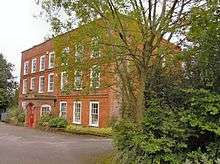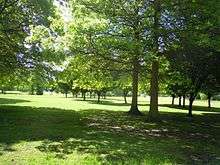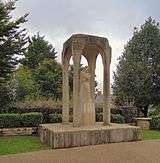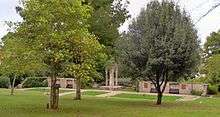Manor Park, Aldershot

Manor Park is an urban park in the town of Aldershot in Hampshire. A short walk from the town centre, it has been a public park since 1919. The former manor house located in the park is Grade II listed.[1] Facilities include a play area, tennis and basketball courts and an all-concrete skate park designed and built by Fearless Ramps and which opened in 2013.[2] Today Manor Park is owned and maintained by Rushmoor Borough Council.[3]
History


The 63 acre Manor Park was purchased by the Aldershot Urban District Council in 1919. The park is close to the site of the old village of Aldershot with a history dating back to Anglo-Saxon times. On the park's perimeter is the original village green and the old parish church of St Michael the Archangel.[4]
The impressive red-bricked three-storey house Manor House located in the park was built in 1670 by Sir Walter Tichborne and was occupied by his family for about 200 years. The Tichborne family had originally lived in an older manor house in Aldershot Park but feeling the need for a larger and grander home they erected the building we see today.
After being sold by the Tichbornes the manor house was home to three generations of the Newcome family, starting with Captain George Newcome, Aldershot’s first magistrate, who bought the estate in 1847.[5] It was his descendant, Captain Newcome RN, who sold the park and manor house to Aldershot Urban District Council in 1919.[5]
For some years the building served as the Register Office for Aldershot; among those who married here was Violette Szabo GC who married the Free French soldier Étienne Szabo at Aldershot Register Office on 21 August 1940 after a whirlwind 42-day romance.[6][7][8] Here too, in 1942, the New Zealand nuclear scientist Clifford Dalton married the scientist and author Catherine Graves (daughter of the writer Robert Graves).[9] It was made a Grade II listed building in 1963[1][3] and is now private offices.[4]
Running across the park is a long path bordered by mature trees. Known as The Major’s Walk, it was planted by Major Newcome, one of the last owners of the Manor, with a variety of trees some of which he brought back from his military service abroad. The fenced duck pond is fed by a natural spring.[4]
Tragedy in the park

Here on August Bank Holiday in 1922 during a crowded Firemen's Fete was murdered Miss Ada Field, aged 29, a bank clerk who for a time had been engaged to William George Warren, aged 23, a clerk in the same bank. They separated, however, and Miss Field then became engaged to Mr Fredrick Reimers.
A week before their planned wedding in the nearby parish church the couple were seated in the reserved enclosure in Manor Park when Warren, who was seated behind her, shot Miss Field through the back, the bullet entering her spine and coming out beneath her chin. Warren then shot himself.
Ada Field was buried in Aldershot Cemetery before a crowd of over one thousand mourners.[10][11][12][13]
Heroes' Shrine


Located in the park is a sunken walled-garden known as the Heroes' Shrine with a large modern statue in Portland stone of Christ calming the storm. The statue is carved from a block rejected by Sir Christopher Wren in the building of St Paul's Cathedral. The statue was carved by Josephina de Vasconcellos to a design by the Borough Surveyor F.W. Taylor.[3]
Aldershot's national memorial, this area serves as both a war memorial and a place of remembrance for the Battle of Britain and the civilians killed in bombing raids across the UK during World War II, particularly during The Blitz.[14]
Originally mounds of masonry were located here salvaged from destroyed buildings from 18 cities and 34 boroughs, including Coventry Cathedral and the Tower of London,[3] with each stone inscribed with the name of the city or area of London from which it came. Today only a few of these remain, cemented into the ground. The monument was unveiled on the 5th May 1950[4] by Prince Henry, Duke of Gloucester.[3]
Near this is a rough-hewn stone monument commemorating the dead of World War I with the inscription, “Their Name Liveth For Evermore 1914- 1919”.
See also
References
- 1 2 Aldershot Manor House, Manor Park, Aldershot - British Listed Buildings website
- ↑ Aldershot Skatepark - The Skateparks Project
- 1 2 3 4 5 Manor Park and Play Area - Rushmoor Borough Council website
- 1 2 3 4 History of Manor Park, Aldershot
- 1 2 'Meet the family that once owned Manor Park in Aldershot' - Get Hampshire website - 5 March 2015
- ↑ Ottaway, Susan (2003). Violette Szabo: The Life That I Have. Barnsley: Pen & Sword Books. ISBN 0-85052-976-X pp=22–25
- ↑ Violette Szabo - The Comprehensive Guide to the Victoria and George Cross
- ↑ Violette Szabo GC Museum website
- ↑ Peter J. Conradi, A Very English Hero: The Making of Frank Thompson, Bloomsbury Publishing Plc, London (2012) - Google Books pg 145
- ↑ 'Victim of Jealousy' - Western Daily Press Bristol, England - 12 August 1922
- ↑ 'Shooting Tragedy at Aldershot' - The Scotsman - 8 August 1922 - British Newspaper Archive - pay to view
- ↑ 'Double Aldershot Tragedy' - Derby Daily Telegraph - 8 August 1922 - British Newspaper Archive - pay to view
- ↑ 'Jilted Lover's Revenge: Farmer's Daughter Shot at Field Sports - Dundee Evening Telegraph - Tuesday 8 August 1922- British Newspaper Archive - pay to view
- ↑ Plans for Memorial Shrine, Manor Park, Aldershot - Sense of Place website
Coordinates: 51°14′38″N 0°45′22″W / 51.244°N 0.756°W